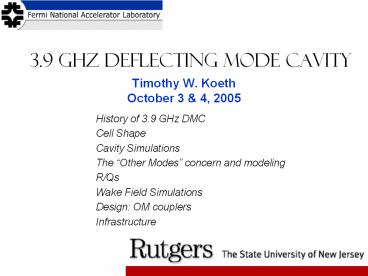3.9 GHz Deflecting Mode Cavity PowerPoint PPT Presentation
Title: 3.9 GHz Deflecting Mode Cavity
1
3.9 GHz Deflecting Mode Cavity
- Timothy W. Koeth
- October 3 4, 2005
History of 3.9 GHz DMC Cell Shape Cavity
Simulations The Other Modes concern and
modeling R/Qs Wake Field Simulations Design OM
couplers Infrastructure
2
Deflecting Mode Cavity History
The Deflecting Mode Cavity (DMC) was initially
planned for use in the CKM fixed target
experiments beam line, but now it finds its
primary use as a diagnostic tool. The operating
frequency, 3.9 GHz, was chosen to be a multiple
of the A0 facilitys 1.3 GHz system. This will
permit the use of the cavity as a beam-slicing
device that can measure the longitudinal profile
of a short bunch.
3
Cell shape CONSIDERATION
- (R/Q), G1, and Bmax-surf were studied for 9
shapes
G1 does not strongly depend on iris radius
A-series 250O B-series 230O C-series 228O
4
Cell shape CONSIDERATION
Frequency separation between the p-mode and the
12p/13-mode needed to have a relative separation
greater than 3E-4
C15 Profile was chosen.
End cells have a slighly different shape to match
the beam tube to the structure.
5
Beam Line Simulations
Full 3-D E-M field made for 13 cell polarized
model was generated in HFSS
Iris
Uniformity map of the the integrated transverse
kick along the the 13 cell cavity
The peak magnetic field along the
cavity. (illustrating field flatness) The
electric field along axis is zero
6
Beam Line Simulations
The 3-D field map was used with the ASTRA code to
understand the cavitys time resolution
The simulation consisted of a bunch composed of
two Gaussian peaks of different intensity and
generation time. This enabled us to compare the
time to spacial correlation preservance.
BLUE Vertical Position
GREEN Time domain
2.0mm ? 730fsec
Resolution 10 to 20 fsec
7
Lower, Same, and Higher Order Modes
Requirement to be maintain the DMC in standby
in the beam line at 4.5 K. Does the cavity have
any problematic modes sitting near the light
cone ? Using MAFIA, dispersion curves for modes
up to cut-off were checked
m 0 modes
m 1 modes
m 2 modes not shown, but modeled.
8
Determination of R/Q
We show the R(m)/Q values for all the modes found
in the 13 cell MAFIA simulation, in units of O
for m 0, O/m2 for m 1, and O/m4 for m 2.
Possible Modes of Concern
TM010 -9p/13 R/Q187 -10 p/13 R/Q354 -11
p/13 R/Q129 TM110 - p (2nd Polr.) R/Q2.3x106
!
9
LOM, SOM, HOM Couplers
INPUT COUPLER Qext 107
SAME ORDER MODE COUPLER 90o rotated Qext105
Qext-op108/9
10
Input Coupler
- Qext 107
- Power Requirement
- 400 Watts
- Coaxial feed through
11
HOM Coupler
- HOM coupler a modification of DESY design
HOM COUPLER
Qext at 3.9GHz 109/10 Qext else 104/5
12
Trapped HOMs ?
- A study of possible trapped HOM above cut-off,
and were compared to R/Q determined by MAFIA.
An example of a potential trapped mode
Freq 5322 R/Q 243O/m2
Possible solution is to increase energy in the
end cells by compressing end cell more than the
body cell.
Knowledge comes from measurement !
13
LOM Coupler
LOM at opposite end of input coupler to reduce
direct capacitive losses from the input coupler
Qext 109/10 _at_ 3.9GHz Qext 104/5 _at_ 3.9GHz
Current design has pertruding tip only 11mm from
cavity axis
14
LOM Coupler Modeling in HFSS
HFSS model was build from I-DEAS surface mesh
file. Both resonances close to design frequency
of 2830 MHz. Notch frequency is 4100 MHz. All
resonances in final tuning range.
F2945
Frequency MHz
15
SOM Coupler
- SOM coupler will be mechanically adjusted to find
the node of the TM110 mode
SOM COUPLERS Qext 104/5 _at_ 3.9GHz
16
Polarization Splitting
?f 50kHz
17
Polarization Splitting
Polarization separation with a copper model
Typical compression is 3mm, which is about 10MHz
separation
18
Wake Field Simulations
Typical Input Parameters
Position angle of offset beam
i.e. The 17th bunch, entering 0.5 mm away from
the center looses 200keV and is kicked 32 µrad
A WORK IN PROGRESS !
19
Vertical Dewar Test Results
Cavity design parameters 13 cells BMAX 80 mT
EMAX 18.6 MV/m L EFF 0.5 m P? 5 M
V/m
20
Vertical Dewar Test Results
Brief Testing History
Cavity Short
Cavity Soft
Cavity Thick
- Possible cause for poor surface resistance
- Contaminated water system(s)
- Hydrogen poisoning from long acid etch
- Cavity orientation wrt to environmental flux
lines ? - Hydrogen in welded region at about 1ppm ?
- Losses on tip of Input Coupler
21
Horizontal Cryovessel
FNAL already has a prototype horiztonal
cryovessel that will host two 3.9 GHz cavities.
With minor modification, we will retrofit for use
in the PhotoInjector Beam line.
Cryogenics Feed
Thermometry, LOM, SOM, HOM ports
Capable of hosting two 3.9 GHz cavities.
RF input Coupler(s)
22
DMC HLRF
We have a 3kW CW 3.9 GHz Klystron for CKM
operation Power requirement is only 400W for 13
cell
23
DMC LLRF
Using DESYs SimCon Series for LLRF control.
Developement and testing with Superconducting
cavities underway at DESY and Fermilab. Successful
demonstration of Piezoelectric suppression of
microphonics.
24
Deflecting Mode Cavity Status
HiGHLY RECOMMENDED READING
FERMILAB-TM-2144 May 2001 RF Design of a
Transverse Mode Cavity for Kaon Separation
Fall 2005 Fine tuning L/S/HOM design December
2005 Cavity assemblies in construction Summer
2006 Finish cavity production Fall 2006
Assembled cavity in cryovessel Winter/Spring
2007 Commission with beam
Acknowledgements Helen Edwards, Leo Bellantoni,
Timergali Khabiboulline, Don Mitchell, Mike
Foley, Allan Rowe, Bill Soyars, Peggy Crayton

